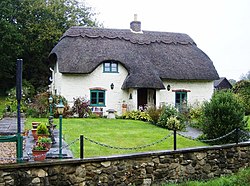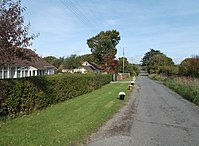Cranmore, Hampshire: Difference between revisions
No edit summary |
No edit summary |
||
| Line 15: | Line 15: | ||
|constituency=Isle of Wight | |constituency=Isle of Wight | ||
}} | }} | ||
'''Cranmore''' is a hamlet strung along convergent lanes on the [[Isle of Wight]], | '''Cranmore''' is a hamlet strung along convergent lanes on the [[Isle of Wight]], [[Hampshire]]. It stands about three miles east of [[Yarmouth, Isle of Wight|Yarmouth]], in the north-west of the island, parted from the [[Solent]] by Bouldnor Cliff, a mile and a half north-west of [[Shalfleet]] | ||
Three areas of grassland, scrub and woodland situated around the village are designated as a Site of Special Scientific Interest: together the three areas cover almost 31 acres. In these areas thrive such species as dormouse (''Muscardinus avellanarius''), red squirrel (''Sciurus vulgaris'') and butterflies and moths such as the nationally scarce small pearl-bordered fritillary butterfly (''Boloria selene'') and Kent black arches (''Meganola albula''). Other species found here include adders (''Vipera berus'') and the common lizard (''Lacerta vivipara''). Above them may be heard nightingales (''Luscinia megarhynchos'').<ref>{{sssi|2000456|Cranmore}}</ref> | Three areas of grassland, scrub and woodland situated around the village are designated as a Site of Special Scientific Interest: together the three areas cover almost 31 acres. In these areas thrive such species as dormouse (''Muscardinus avellanarius''), red squirrel (''Sciurus vulgaris'') and butterflies and moths such as the nationally scarce small pearl-bordered fritillary butterfly (''Boloria selene'') and Kent black arches (''Meganola albula''). Other species found here include adders (''Vipera berus'') and the common lizard (''Lacerta vivipara''). Above them may be heard nightingales (''Luscinia megarhynchos'').<ref>{{sssi|2000456|Cranmore}}</ref> | ||
| Line 23: | Line 23: | ||
==References== | ==References== | ||
{{ | {{reflist}} | ||
[[File:Cranmore, Isle of Wight, UK.jpg|left|200px|Cranmore, Hampshire]] | |||
Latest revision as of 23:04, 29 September 2022
| Cranmore | |
| Hampshire | |
|---|---|
 Myrtle Cottage | |
| Location | |
| Island: | Isle of Wight |
| Grid reference: | SZ397899 |
| Location: | 50°42’29"N, 1°26’17"W |
| Data | |
| Post town: | Yarmouth |
| Postcode: | PO41 |
| Dialling code: | 01983 |
| Local Government | |
| Council: | Isle of Wight |
| Parliamentary constituency: |
Isle of Wight |
Cranmore is a hamlet strung along convergent lanes on the Isle of Wight, Hampshire. It stands about three miles east of Yarmouth, in the north-west of the island, parted from the Solent by Bouldnor Cliff, a mile and a half north-west of Shalfleet
Three areas of grassland, scrub and woodland situated around the village are designated as a Site of Special Scientific Interest: together the three areas cover almost 31 acres. In these areas thrive such species as dormouse (Muscardinus avellanarius), red squirrel (Sciurus vulgaris) and butterflies and moths such as the nationally scarce small pearl-bordered fritillary butterfly (Boloria selene) and Kent black arches (Meganola albula). Other species found here include adders (Vipera berus) and the common lizard (Lacerta vivipara). Above them may be heard nightingales (Luscinia megarhynchos).[1]
Outside links
| ("Wikimedia Commons" has material about Isle of Wight Cranmore, Hampshire) |
References
- ↑ SSSI listing and designation for Cranmore

